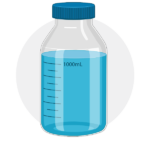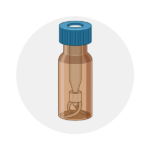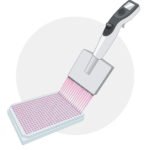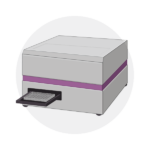Our methods
The great strength with effect-based methods is that they detect and quantify effects of all hazardous compounds in a sample
The whole iceberg, not just the tip
Tens of thousands of chemicals can potentially contaminate our waters. Despite that, chemical hazards in water is currently monitored mainly by target chemical analysis, a methodology that only detects a very limited number of all the chemical substances that can contaminate water.
Many international research studies have shown that up to 99% of the effects that can be detected with effect-based methods cannot be explained by the chemicals identified by chemical analysis. A vast majority of the toxicity is caused by unknown chemicals or cocktail effect. Thus, focusing only on the concentrations of known chemicals resembles looking only on the tip of an iceberg. With such a strategy, there is a great risk that chemical hazards from unknown compounds or cocktail effects pass undiscovered. Effect-based methods allow us to gain a holistic view of chemical hazards in water, by looking on the entire iceberg of effects.

A battery of cell-based tests
We use a battery of cell-based tests to measure toxic effects that are relevant for human and environmental health, such as endocrine disruption and DNA damage.
Mammalian cells, which are cultured in the laboratory, have been modified to respond to specific toxic effects. When the cells are exposed to a sample that contains chemical substances, causing for example estrogenic effects, the cells produce a signal protein that is easily detected by luminescence. By treating the cells with a water sample and then measuring the amount of produced signal protein, we investigate whether, and to which extent, the sample is contaminated with hazardous chemicals. The methods are suitable to monitor drinking water quality and efficiency in wastewater treatment, to perform environmental monitoring and to evaluate new technical solutions in the water industry.
Which effects can we measure?

Estrogens and androgens have many important physiological functions: reproduction, cardiovascular, immune, muscular, and nervous systems
Examples of chemical pollutants in water that affect sex hormone receptors include natural sex hormones, birth control pills, pharmaceuticals used to treat breast and prostate cancer, as well as plant-based isoflavones and certain plastic chemicals

The aryl hydrocarbon receptor (AhR) has many different physiological functions, such as in the development of various organ systems and in the regulation of inflammatory responses. Many toxic substances activate the Ah receptor, including halogenated organic environmental pollutants, polycyclic aromatic hydrocarbons (PAHs), certain pesticides and pharmaceuticals, as well as naturally occurring substances like indoles and stilbenes.
Oxidative stress is a common mechanism behind various types of toxic effects, such as inflammatory effects and cancer. Many toxic substances, such as organic environmental toxins, pesticides, and natural compounds, can cause oxidative stress. Oxidative stress is also induced by disinfection by-products, which can form during water treatment.
Both AhR activity and oxidative stress can be seen as environmental sensors:
an indication of the level of pollution.

Genotoxicity or DNA damage is a serious effect, which requires extensive testing and investigation for registration of chemicals such as pesticides, food additives and flavorings. DNA damage in body cells can lead to cancer and to reproductive disorders when affecting germ cells.

Many pollutants can cause acute toxicity, for example in fish. This is a very serious adverse effect that is important to monitor in environmental waters and recipients affected by discharge of effluent wastewater
It is now possible to efficiently evaluate acute toxicity in fish by using cultured fish cells, instead of using real animals
Follow our process
We need 1 L water sample sent to our lab in Uppsala.
When the samples arrives a solid phase extraction is performed – just like for chemical analysis of organic micropollutants.
Water sample
Solid phase extraction
Cells that are sensitive to different effects are exposed to water samples and reference substances in dilution series.
The water extract is usually concentrated 5000 times but is then diluted in the medium the cells grow in.
The occurrence of toxic chemicals in the sample is analyzed with cultured cells
Concentrated water sample
After 24 hours exposure the amount of signal protein is measured which the cells produce in relation to the amounts and potencies of bioactive substances in the sample.
Results from the reference substances are used to express the effect in a sample as a concentration of the reference substance in a biological equivalent concentration – BEQ.
The amount of signal protein is measured
Results are compiled and analyzed
Step by step - Water Analysis
1. Water sample
We need 1 L water sample which is sent to our laboratory in Uppsala. The sampling bottles have been carefully tested to assure that no compounds we measure effects from are leached from the bottles (or bound to the bottle material).


2. Solid phase extraction
When samples arrive to our laboratory a solid phase extraction is performed (just as for chemical analysis of organic compounds) in order to concentrate the water sample and the compounds we want to measure effects from.
3. Concentrated water sample
The water extract is usually concentrated 5000 times but is then diluted in the cell growth medium. We measure effects in dilution series commonly at a relative enrichment factor (REF) of 1-50.


4. The occurrence of toxic chemicals in the sample is analyzed with cultured cells
The concentrated sample is added to different cell lines, usually human cells. The cells have been modified to detect specific effects such as endocrine disuption or oxidative stress in what is called reporter gene assays. When the cells are exposed to a sample that contains compounds causing the specific effects the reporter gene is activated and the cells produce a signal protein.
5. The amount of signal protein is measured
The amount of signal protein is measured both in samples and for the reference substances that are specific for each assay. Results for the reference substances are used to translate effects in samples to biological equivalent concentrations (BEQ) of the reference substances. For example, estrogenic effects are expressed as estradiol equivalents per litre water sample where the effect may come from several different compounds or mixtures with estrogenic activity. BEQ values can be used to compare effects between different studies.


6. Results are compiled and analyzed
BEQ values are compiled for active samples and can thereafter be compared with values from other studies or historical data. Average or median values and percentiles demonstrate reference values and define a ”normal” interval. Measured effects can be compared to this interval and deviating values indicate that a water should be further investigated. Some of the assays have suggested benchmark values (so called effect-based trigger values – EBT) relevant for human health or the environment.

